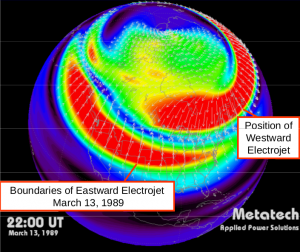
John Kappenman reconstructed the electrojets which formed in the ionosphere late in the March 13, 1989 geomagnetic storm which compromised the Hydro-Quebec power grid in Canada. Concurrently, the eastward jet induced ground currents that severely strained the electrical distribution grid of northern continental United States, resulting in a transformer failure at the Salem Nuclear Power Plant, in New Jersey. Courtesy of Metatech
Nearly a quarter century ago, on March 13, 1989, a geomagnetic storm led to the collapse of the Hydro-Quebec electrical grid system, which furnishes power to much of the province of Quebec, Canada. So pervasive were abnormal currents, that protective circuit breakers tripped throughout the system, bringing the entire grid to a halt in about one and a half minutes. The grid’s self-protective systems were geared toward local abnormalities happening in particular places. In contrast, ground induced currents created abnormalities everywhere. The good news was that most of the hardware protected itself. The bad news was that six million customers were without power for as long as nine hours, and where transformer damage did occur, outages continued for another week.
Further south, the United States experienced a close shave. A second surge in the March 13 storm generated similar ground induced currents in the northern United States, with large current spikes observed from the Pacific Northwest to the mid-Atlantic states, one spike destroying a large GSU transformer at the Salem Nuclear Power Plant in New Jersey. According to John Kappenman, of the Metatech Corporation “It was probably at this time that we came uncomfortably close to triggering a blackout that could have literally extended clear across the country.”
The March 13th 1989 storm did not arise from the largest geomagnetic storm of the twentieth century; the May 16, 1921 solar storm induced ground currents ten times greater than the 1989 storm. It caused telegraph keys to chatter by themselves; one even shut down the New York Central Railroad in New York City when induced electromagnetic currents caused it to arc and set fire to the 57th Street control tower.
The maximum rate of change in magnetic flux of the March 13 1989 storm was roughly 500 nano-Teslas per minute. The May 1921 storm exhibited much more vigorous flux changes, estimated to be closer to 5,000 nano-Teslas per minute. Fortunately, there was no such thing as a national grid in 1921. While the linking of hitherto isolated power companies into larger grids was well under way by the 1920’s, the country as a whole consisted of disjoint grid systems, with many parts unelectrified. Consequently, the storm was not a seminal disaster to that generation, just a mere curiosity.
The 1989 and 1921 storms are overshadowed by the so-called 1859 Carrington Event, named for English astronomer Richard Carrington whose observations on the 1859 storm led him to understand the connection between solar coronal activities and earthly auroras. Northern lights were reported as far south as Cuba and Honolulu, while southern lights were seen as far north as Santiago, Chile, and newspapers could be easily read in the auroral light across most of the United States. As in the 1921 event, telegraph operators reported sparks leaping from their equipment, the induced current in some lines permitted operators to key messages without using dry cells – others were electrocuted when they touched their keys. If traces found in Greenland ice cores are to be believed, the Carrington storm, estimated at 7,500 nano-Teslas per minute, was a once-every-500 year occurrence. Of course, this does not mean we are off the hook until 2359. Ice cores show massive storms occurring within a century of one another as well as centuries of tranquility.
The day we lost Quebec, we didn’t have the worse blackout on record. That was to come fourteen years later, on August 14, 2003, when we lost Quebec, Ontario, and a large swath of Eastern United States. That event, however, had root causes well within everyone’s grasp. Hot day. Wires sagged and hit some trees that should have been trimmed. A bit of human inattentiveness, some bad software, and a shake or two of defective policy were added, compounding into catastrophe what should have been contained. These are the kind of problems that can be fixed with fines, firings, and better training. In contrast, the geomagnetic storm manifested itself everywhere on Quebec-Hydro’s grid. It was strange. A quarter century on, and not everybody is convinced that we know how to handle these things. The 1989 event, though the smallest of the three geomagnetic storms, best illustrates the effects of a CME on an essentially modern electrical distribution system, which was non-existent in 1859 and relatively small in 1921. We have yet to experience the ‘Katrina’ of space weather: the contest between a twenty-first century power grid against an 1859 – or even 1921 – scale geomagnetic storm.
Next – Part Two: The Physics of Geomagnetic Storms.